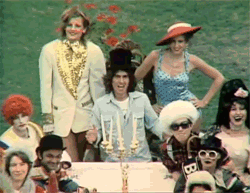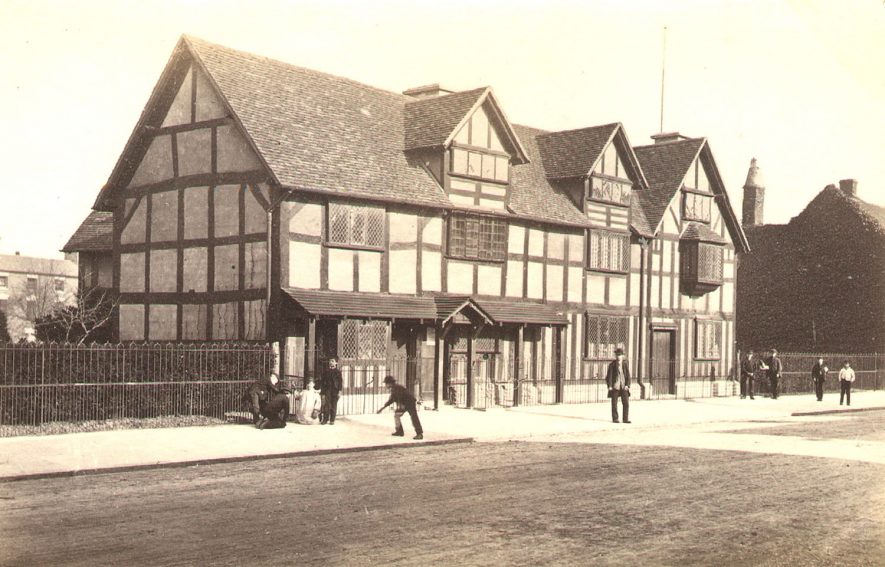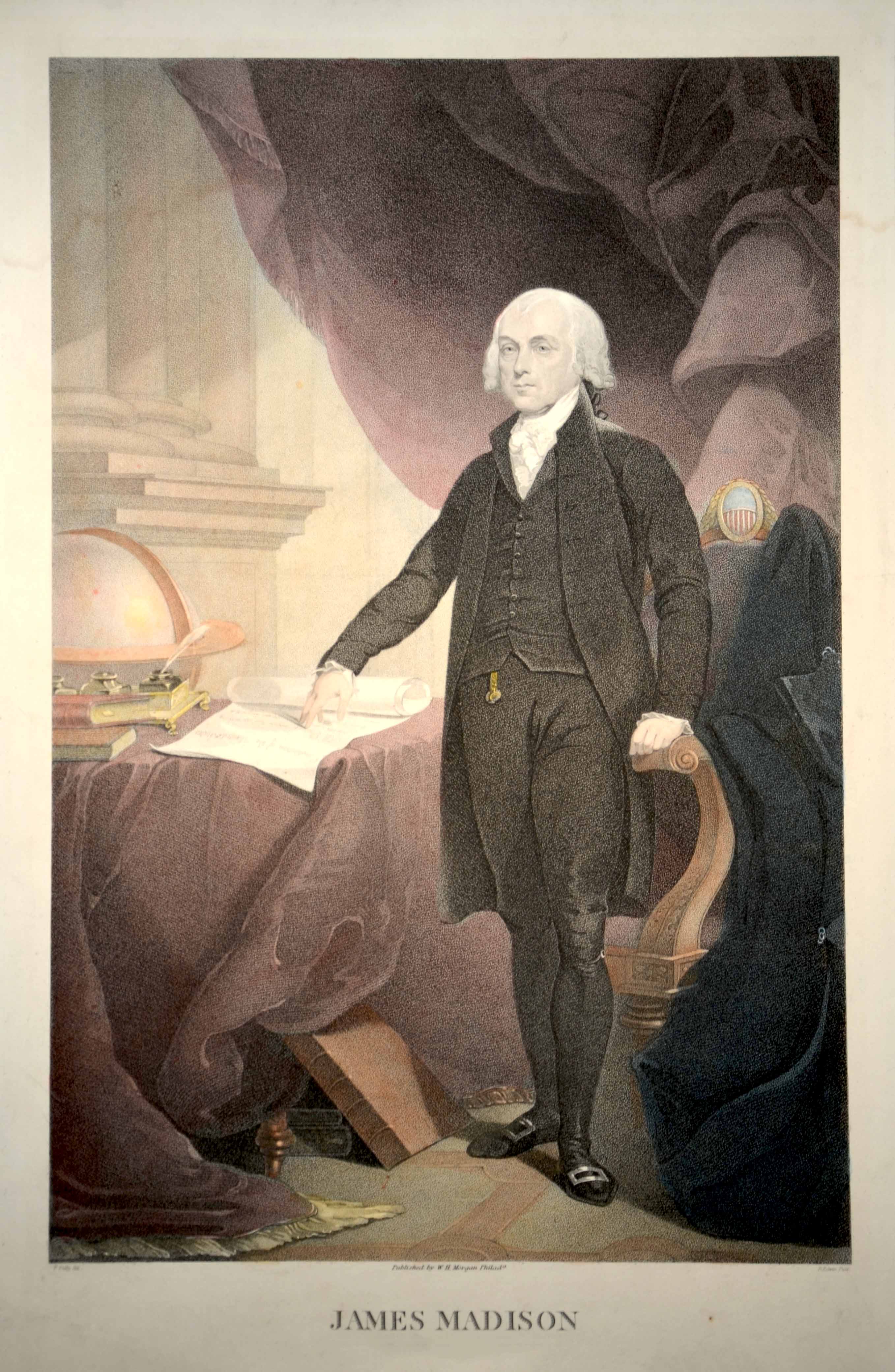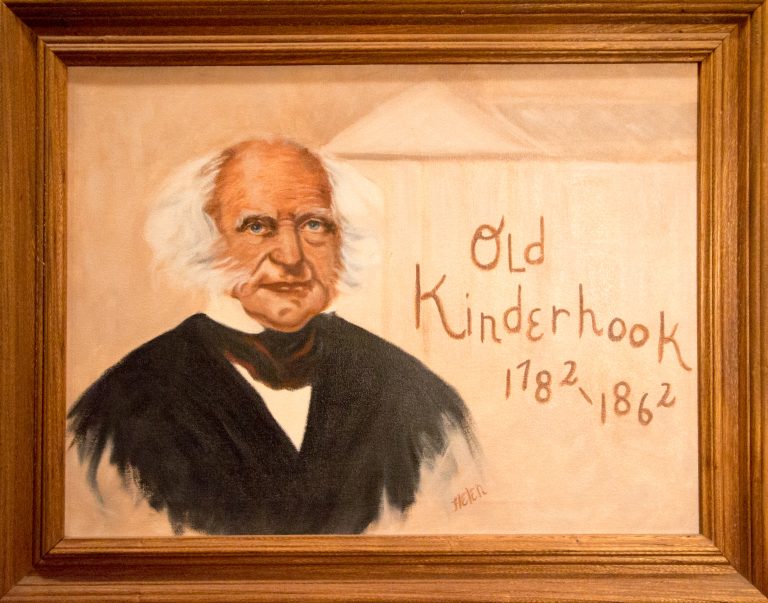
make celebrity GIFs like this at MakeaGif
10. He was the first Beatle to visit, and play, in America.
In the fall of 1963, Harrison traveled to Benton, Illinois to visit his sister, Louise, and her husband, George Caldwell. During his 18-day stay, Harrison also became the first Beatle to play in the U.S.—appearing on stage with The Four Vests at the VFW Hall in Eldorado. He played the second set with the band, taking over lead guitar and singing "Roll Over Beethoven" and "Your Cheatin' Heart."
Harrison wrote “Don’t Bother Me,” his first first solo composition, while sick in bed at the Palace Court Hotel in Bournemouth, England, in the summer of 1963. It “was an exercise to see if I could write a song,” Harrison said. “I don't think it's a particularly good song ... It mightn't even be a song at all, but at least it showed me that all I needed to do was keep on writing, and then maybe eventually I would write something good." “Don’t Bother Me” appeared on With The Beatles, their second studio album.
EMI Films, Life of Brian’s original backer, withdrew funding for the Monty Python comedy classic just before filming began, scared that the religious subject matter would be too controversial. Harrison, a big fan and friend of the Pythons, set up his own production company—Handmade Films—to fund the project. Why? "Because I liked the script and I wanted to see the movie,” he explained. Harrison not only saw the film, he appeared in it, as Mr. Papadopolous, "owner of the Mount.” Monty Python’s Life of Brian, released in 1979, was a huge hit in both the UK and U.S., and was ranked as the 10th best comedy film of all time in 2010 by The Guardian.
During the band’s early years, they had extended runs as a house band in Hamburg, Germany, and were paid so poorly (and had to be on stage for so many hours) that they shared a small room in the club’s basement. Hence the witnesses to George’s deflowering, at age 17. "We were in bunkbeds," Harrison recalled. "They couldn't really see anything because I was under the covers, but after I'd finished they all applauded and cheered. At least they kept quiet whilst I was doing it."
"He never shut up," friend and fellow Traveling Wilbury Tom Petty once said of Harrison. "He was the best hang you could imagine."

Harrison nicknamed his 120-room Friar Park mansion “Crackerbox Palace” after a friend’s description of Lord Buckley’s tiny Los Angeles home. The 66-acre property, about 37 miles west of London, was first owned by Sir Frank Crisp, a lawyer who lived there from 1889 to 1919. Harrison bought the estate in 1970—and quickly penned “The Ballad Of Sir Frankie Crisp,” which appeared on his first solo album, All Things Must Pass, also in 1970. Friar Park was a strange place, with gnomes, grottos, a miniature Matterhorn, and lavish gardens, which Harrison loved to tend.

According to the Victoria County History website, the house itself “is an architectural fantasy in red brick, stone, and terracotta, mixing English, French and Flemish motifs in lavish, undisciplined profusion.”
Before Harrison organized the 1971 Concert for Bangladesh, there were performances for charity, of course. But when his friend, the great Indian sitar player Ravi Shankar, told him about the plight of Bangladeshi refugees, victims of both war and a devastating cyclone who now faced starvation, Harrison felt compelled to devote himself to the cause. He recruited stars like Eric Clapton, Bob Dylan, Ringo Starr, Billy Preston, Badfinger, and Leon Russell, and together they played two sold-out shows at Madison Square Garden on August 1, 1971. Harrison then arranged for the release of a concert album and film. The ventures had raised more than $12 million by 1985, and profits from sales of the movie and soundtrack continue to benefit the George Harrison Fund for UNICEF.
George Harrison turned 27 on February 25, 1970, less than two months before Paul McCartney told the world he had no future plans to work with the Beatles. It had been 12 years since Harrison had joined John Lennon’s band, The Quarrymen—shortly after McCartney, his Liverpool schoolmate—in 1958.

Washington was an ultra-successful liquor distributor in the new country. He made rye whiskey, apple brandy and peach brandy in his Mount Vernon distillery.

Adams and Thomas Jefferson were close friends and correspondents — but they also had a bit of a rivalry. Adams' dying words were, "Thomas Jefferson survives," unaware that he had died hours earlier. In another shocker, both died on July 4, 1826.

Jefferson and John Adams paid a visit to William Shakespeare's home in Stratford-upon-Avon in 1786. There, they chipped off a piece from Shakespeare's chair as a souvenir.

James Madison was Princeton University's first graduate student.

Monrovia, the capital of the Liberia, is named after James Monroe. He supported the American Colonization Society in its work to create a home for freed slaves in Liberia.

During his presidency, John Quincy Adams enjoyed skinny-dipping

in the Potomac River in the early mornings.
Jackson was involved in as many as 100 duels, most of which were fought to defend the honor of his wife, Rachel. He was shot in the chest in a duel in 1806 and took a bullet in the arm in a bar fight with Missouri Sen. Thomas Hart Benton in 1813.

Van Buren's nickname was "Old Kinderhook" because he was raised in Kinderhook, N.Y. A popular theory states that the term "O.K." is derived from the O.K. clubs that sprung up to support his campaign.

Democrats ran a smear campaign during Harrison's campaign that tried to cast him as an out-of-touch old fogey who would rather "sit in his log cabin, drinking hard cider" than run the country. Harrison one-upped the haters by adopting the log cabin and hard cider as campaign symbols. He even commissioned bottles of hard cider shaped like log cabins.

John Tyler had 15 children, more than any other president. Two of his grandsons are still alive today. One of Tyler's children, Lyon Gardiner Tyler, born in 1853, fathered Lyon Gardiner Tyler Jr. in 1924 and Harrison Ruffin Tyler in 1928.
Here's one for the underdogs. James Polk, nicknamed "Young Hickory," was America's first dark horse presidential candidate. He was considered a Plan B after the more likely choice, Martin Van Buren, failed to secure the party's nomination.
Zachary Taylor was a tough guy — a major general in the U.S. Army and hero of the Mexican-American War. But oddly enough, what brought him down in the end was a glass of milk and some cherries that he enjoyed on July 4, 1850. The cherries were likely contaminated with bacteria that caused his death by cholera five days later.

Millard Fillmore lived the dream of many a teenage schoolboy. Fillmore's first wife, Abigail Powers, was his teacher while he was a 19-year-old student at the New Hope Academy in New York.

Pierce had a tough time guiding the nation and perhaps an even tougher time guiding his horse. During his presidency, Pierce was arrested for running over a woman with his horse. Charges were later dropped due to a lack of evidence.

James Buchanan regularly bought slaves in Washington, D.C. and quietly freed them in Pennsylvania.*********************************************************************************************************************


Sorry in-advance to all men.. Because it looks like you’ll be spending twice as much as women this year on gifts. The average man spends $130 on Valentine’s Day, while as of 2019 records and before women spend about $70.
Hard to believe in some ways that February 14th is the second largest card giving day of the year, just after Christmas. This year, it’s expected that 1 billion cards will be exchanged around the world.
Teachers are the big winner in this category. Because its teachers who receive the most Valentine’s Day cards, followed by kids, mothers, wives and girlfriends.

Let's be honest from the survey, more than one-third of men are comfortable not receiving anything from a lover on Valentine’s Day.

It’s estimated that the U.S. alone is going to spend $3.3 billion on flowers for loved ones this year. It's the easy way to survive this holiday!!

Would you believe that young people are leading the trend in floral sales? In 2016, 63% of floral-buying households were under the age of 35.

Historians believe Valentine's Day actually began in Ancient Rome as a pagan fertility festival called Lupercalia, with the celebration dedicated to Faunus, the Roman god of agriculture, and Roman founders Romulus and Remus. According to History.com, the day was celebrated with activities that included sacrificing animals and whipping women with animal skins until they bled, signifying their fertility.

In fact, he might have been two or three. But the most common "founder" of Valentine's Day was the Saint Valentine who defied Emperor Claudius II. At the time, Claudius had banned marriage because he thought it distracted young soldiers. Valentine felt a bit differently — he illegally married couples until he was caught. After he was sentenced to his death, young couples would visit his cell and give him flowers and cards. And the day he actually died? February 14. Allegedly. But there have been multiple St. Valentines throughout history, including a bishop and one Pope (he only served for 40 days in 827 A.D.).
The oldest record of a valentine being sent, according to History.com, was a poem written by a French medieval duke named Charles to his wife in 1415. Charles penned this sweet note to his lover while he was imprisoned in the Tower of London at just 21 years old. One of the lines in the poem? "I am already sick of love, My very gentle Valentine." Swoon!